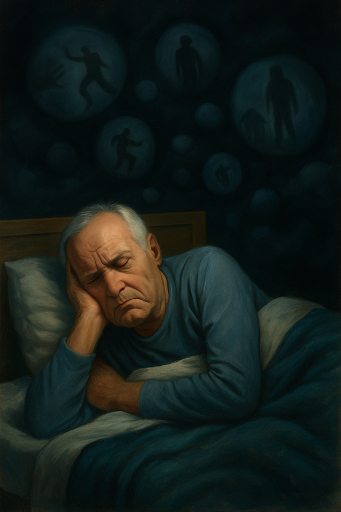🧠 A Scientific Analysis of How Dream Content Changes with Age
As we grow older, changes affect not only the body but also our mental and emotional patterns, including the nature of our dreams. Many seniors report experiencing frequent nightmares or unsettling dreams. But is this phenomenon normal? And what factors contribute to these changes?
🌙 Why Do Dreams Change with Age?
📉 Decrease in Deep Sleep
Aging leads to a reduction in deep (NREM) sleep stages and an increase in lighter sleep phases, making it more likely to recall dreams, especially disturbing ones.
🔄 Changes in Brain Chemistry
Alterations in neurotransmitters such as serotonin and dopamine can impact sleep regulation and dream content, often resulting in emotionally intense or disordered dreams.
🧓 Aging-Related Psychological Stress
Loneliness, bereavement, and chronic health conditions elevate stress and anxiety levels, which are reflected in dream content.
😴 Types of Disturbing Dreams in Older Adults
| Type | Description |
|---|---|
| Recurring Nightmares | Frightening dreams that often wake the sleeper and involve danger or death. |
| Nostalgic Dreams | Dreams featuring lost loved ones or youth, usually with mixed emotions. |
| Anxiety Dreams | Dreams involving loss of control or helplessness. |
| Confused Dreams | Disjointed or nonsensical dreams, sometimes related to cognitive decline. |
💡 Scientific Causes Behind These Dreams
-
Sleep disorders such as insomnia or sleep apnea.
These disrupt normal sleep cycles and increase the likelihood of vivid or unpleasant dreams. -
Certain medications for mood or blood pressure.
Some drugs have side effects that impact sleep and dream quality. -
Neurodegenerative diseases like Alzheimer’s.
These affect brain regions responsible for dream regulation and memory processing. -
Mental health conditions, such as anxiety or depression.
Common among seniors, they significantly shape emotional tone in dreams.
🧘♂️ How to Reduce Disturbing Dreams
-
🕯️ Create a calming sleep environment: Use dim lighting, maintain a comfortable temperature, and reduce noise.
-
📖 Avoid negative media or stress-inducing content before bedtime.
-
🧠 Practice relaxation techniques: Deep breathing, guided imagery, or light meditation.
-
📋 Keep a dream journal: Helps identify recurring patterns and better understand emotional triggers.
-
🩺 Consult a physician: If nightmares persist or interfere with well-being, professional evaluation is recommended.

